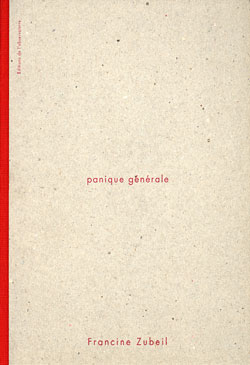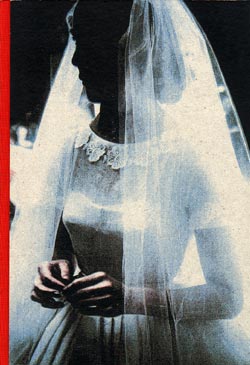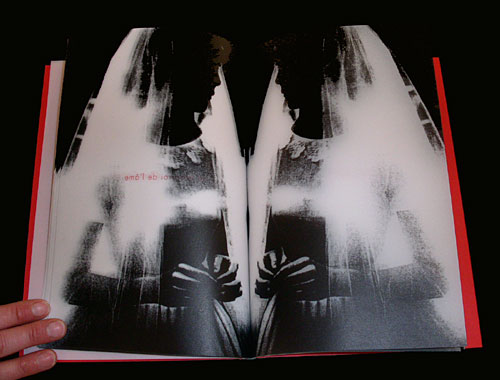 |
 |
Panique générale 1993
Livre d’artiste, 72 pages, format 17 x 24,5 cm
Impression offset 2 couleurs sur papier calque, couverture en sérigraphie sur carton
Éditions de l’observatoire, Marseille, collection en aucun lieu
500 exemplaires numérotés |
 |
Panique Générale par Francine Zubeil (Marseille, Edition de l’Observatoire, 93) est le deuxième d’une série de livres d’artistes "en aucun lieu", publié en une édition de 500. Ce très beau travail est la répétition d’un négatif d’un corps de femme voilé, imprimé sur papier calque avec de courtes phrases imprimées en rouge sur quelques unes des pages de droite. Le texte se voit par transparence, montrant divers modèles de panique et d’anxiété comme indiqués par les mots. L’image ne change jamais, mais elle est imprimée sur les deux côtés de la reliure pour que l’image fasse parfois face à son pendant. Les mains semblent nerveuses, les doigts se cherchent mais ne font que se toucher. Il y a une tension dans les coudes pliés et la moue des lèvres. Est-ce une communion ou un mariage ? Y a-t-il vraiment "disparition" lorsque le mot disparition semble disparaître à la fin du livre en très petits caractères ? Quel est le mystère dans ce travail ? Il est là.
In Umbrella n° 1 California, 1994
Looks how feminine roles are written, specifically the long-playing part of life.Between blood-red endpapers, the entire book is printed on milky white translucent stock, four blank pages of which introduce and conclude it. Within this dense veil, the same black and white photograph of an elelgant but anxious young bride appears on every page. Her face is turned away in shadow, and she is nervously picking her fingers, though otherwise composed. On every other page there is a single line of text, in frenc, printed in fine red letters. The first is, simply, Oubli, it means forgetting, inthe most common usage, but also neglect, oversight, omission.
Allusive references to the perils of matrimony follow -its banal necessity, the sensation of suffocation, of crushing, but Zubeil also writes of the less simple confusion entailed by making such a pledge : the noise of emotion, the passion of this oubli. Though its components are simple and few, this is an exeptionalaly well planned book, in which detail is made to count. The image of the bride is printed alternately on the frontor back of each translucent sheet, for instance, which allows the complementarily alternating text to be legible, but also create a subtle rhythm of shadow and veil.
As the pages are turned, the reversed image enters into colloquy with its twin; the first time this happens, ilduo appears on the verso, the possibility fortuitous reverse of oubli. And the last time the pages are turned, the photo is flipped, terminating an internal dialogue that hadclosed on the phrase, one no longer knows if ine is lying about it. The word disparition in smaller type still, appears after an interval. Wether the mariage is understood as a betrothal to a particular man, or, only slightly less satisfactorily, as a vow of loyalty to a conventional social order, this is a book suffiently nuanced, even ambiguous, but utterly convincing. |
|
|
|